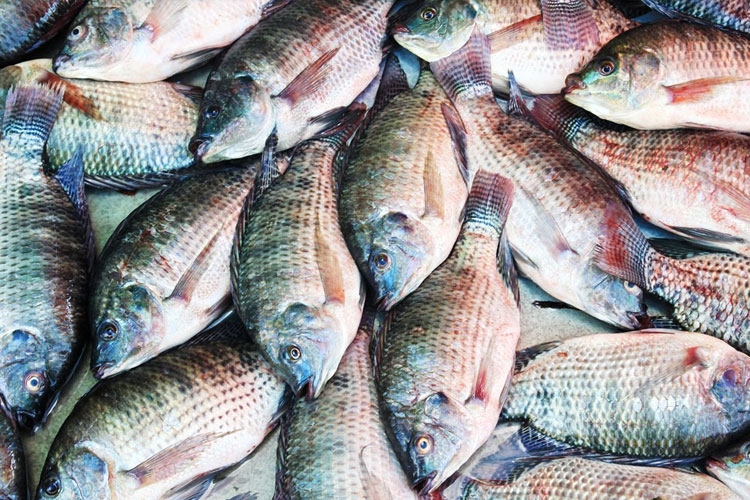The true chicken-of-the-sea, tilapia is a mild-tasting white fish that’s cheap to breed and easy to sell.
In fact, for the first time in 2012, farmed fish production topped that of beef, reaching a record 66 million tons, compared with beef at 63 million. But there’s a dirty secret about tilapia, the lean-meat alternative that beckons you in the supermarket–promises of weight loss, a healthy heart and beautiful skin ringing in your ears. While most health experts agree we should be eating more fish (for all the reasons listed above), this Eat This, Not That! research has found the inflammatory potential of farmed tilapia to be greater than a burger, doughnuts—even pork bacon! It gets worse …
It’s the Worst Kind of Fat
Compared with other fish, farmed tilapia contains relatively small amounts of beneficial omega-3 fatty acids–the heart-healthy and essential fish oils touted by health and nutrition experts as the main reason to eat fish frequently. While a portion of salmon has over 2,000 milligrams of omega-3 fatty acids, a serving of tilapia has a mere 135 milligrams. Moreover, because farmed tilapia subsist on a diet of corn and soy instead of lake plants, they’re proportionally sky high in omega-6 fats, which studies have proven to harm the heart, the brain, and even your mood. The Wake Forest University study that produced the tilapia vs. bacon findings revolves around this dangerous omega 6:3 proportion.
They Have the Crappiest Diet
There’s a good chance the tilapia on your plate was raised on a poop diet (that’s poop as a noun, not an adjective). Research from the Johns Hopkins Center for a Livable Future revealed the gory details of disease-ridden fish farms in Asia, where pig and chicken feces serve as a cheaper alternative to standard fish food. While the FDA vehemently denied any of these goings-on, the Johns Hopkins investigation revealed only 2 percent of imported seafood to the United States is actually tested for contamination. It’s not just mega gross. Experts worry that the large amounts of antibiotics given to the fish to ward off infections may give rise to antibiotic-resistant strains of salmonella.
They’ve Had a Sex Change
Virtually all tilapia sold in American supermarkets has undergone a sex change–the result of being fed methyltestosterone during the early, sexless stage of life. Tilapia pumped full of hormones grow bigger quicker than their natural bros, because they don’t expend energy developing reproductive organs and require less food. Seafood experts consider the effects of methyltestosterone in fish to be insignificant to our health. However, there’s research to suggest the drug can be highly toxic to the liver. In fact, methyltestosterone has been taken off the market in Germany due to its high potential for liver toxicity.
They Cause a Negative Environmental Impact
Environmentalists argue that intensive and unregulated tilapia farming is damaging ecosystems, leaving dead lakes and extinct species in poor countries with practices prohibited in the United States. In Nicaragua, for example, huge numbers of fish are bred in cages, where fish waste pollutes the lake water. Such was the case at Lake Apoyo, where pollution killed off the aquatic plants, leaving the lake a wasteland.
Eat This, Not Tilapia!
When it comes to choosing a fish that qualifies as one of the foods that will help you lose weight and one of the healthiest for your body—and the Earth—abide by the number one rule: Stay off the farm. Farmed seafood, not just tilapia, can have up to 10 times more toxins than wild fish, according to Harvard Researchers. Your best choices at the fish counter include: Wild Alaskan Salmon, Alaska Pollok, Atlantic Cod, Clams, Blue Crab, Atlantic Mackerel, Striped Bass, Sardines, Herring, Rainbow Trout and Flounder.
Written by Eat This.com




